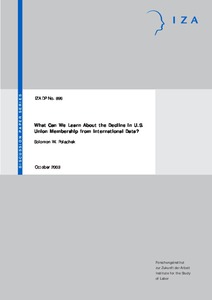What can we learn about the decline in U.S. union membership from international data?
"This paper is composed of two parts. First, using international data, I corroborate that union density in the U.S. declined because of asymmetric growth between the union and nonunion sectors. I show union density to increase in countries experiencing strong manufacturing growth, and to declin...
| Main Author: | |
|---|---|
| Institution: | ETUI-European Trade Union Institute |
| Format: | TEXT |
| Language: | English |
| Published: |
Bonn
2003
IZA |
| Subjects: | |
| Online Access: | https://www.labourline.org/KENTIKA-19126911124919441939-What-can-we-learn-about-the-de.htm |
| Summary: | "This paper is composed of two parts. First, using international data, I corroborate that union density in the U.S. declined because of asymmetric growth between the union and nonunion sectors. I show union density to increase in countries experiencing strong manufacturing growth, and to decline in countries undergoing large women’s increases in nonagricultural employment. Second, I borrow from international relations research on war and peace to develop a cogent reason why union density differs by sector. In this vein, I apply a model primarily used to describe bilateral political interactions to figure out why workers often engage in hostile activities such as strikes. In doing so, I look at the contentious rather than the cooperative “face” of unions." |
|---|---|
| Physical Description: | 23 p. Digital |

